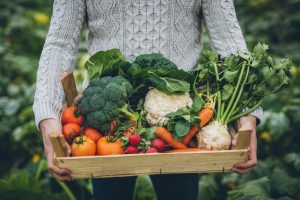Starting Your Vegetable Garden: A Beginner’s Guide
Have you ever dreamt of growing vegetables and enjoying the freshest, tastiest produce from your backyard? If so, reality! Starting your vegetable garden is not as difficult as you might think, and it’s an enriching experience that can save you money and improve your daily meals.
This guide will walk you through the essential steps to create a thriving garden, even if you’re a novice.

Reap the Benefits of a Home Vegetable Garden
Growing your vegetables can help you save on grocery costs, provide healthy foods, and add convenience to your daily life. Plus, gardening is a great way to spend time outdoors, exercise, and connect with the food you eat. So why not give it a try?
Required Tools & Materials
If you’ve never done a vegetable garden before, there will be a few supplies you may need to purchase to get started. We recommend the following tools and materials:
- Spade or shovel- This will be used to prepare the soil and dig holes for planting. When choosing a spade or shovel, be sure to purchase a quality-made one because you will be using it often.
- Rake- A rake will help you to level the soil and remove debris.
- Seeds or seedlings – Decide what vegetables you want to grow, then purchase seeds or starter plants from your local garden center.
- Fertilizer or compost – Fertilizer will provide the necessary nutrients for your plants, while compost can help improve soil quality.
- Mulch- Mulch helps soil retain moisture and prevent weeds from growing.
- A hoe- This is useful for breaking up soil and removing weeds.
- Pruners or scissors – Keep your plants tidy and healthy by trimming off dead or damaged leaves.
- Hand trowel- This small tool is perfect for digging holes for planting and transplanting seedlings.
- Wheelbarrow- This tool is great for transporting heavy bags of soil or large amounts of garden waste.
- Watering can- A watering can is helpful for more precise watering, especially for delicate seedlings.
- Long-handled manure or hay fork- This is an excellent tool for turning compost and spreading mulch.
- Garden twine- Use garden twine to tie up tall plants for support as they grow.
In addition to garden tools, you should purchase a few things to ensure your comfort and safety while tending your garden, including a hat, sunscreen, and a pair of suitable gardening gloves.
Gardening Steps: Your Path to a Bountiful Harvest
Find the perfect spot
Choose a sunny site that is easy to access. Your garden will need at least 6-8 hours of sunlight per day, so make sure the location gets plenty of exposure.
Stay close to the water
Have a water source nearby to make watering your plants as convenient as possible.
Decide on your garden type
Do you want to strip the turf and plant directly into the ground, or would you prefer to build raised beds? Both methods have benefits; the choice will depend on your preferences and available space.
Select your crops
Choose what you want to grow by researching which plants thrive in your area. Make a list of your favorite vegetables and cross-reference it with what grows best in your region. Common vegetables grown in Pittsburgh include tomatoes, cucumbers, peppers, zucchini, and leafy greens like lettuce and spinach.
Start your seedlings indoors
To give your plants a head start, begin by germinating your seeds indoors before transplanting them to your garden. This will help ensure strong, healthy plants that yield a high-quality harvest.
Prepare the soil
Use a spade or shovel to loosen the soil and remove any debris. Mix in compost or fertilizer to provide nutrients for your plants.
Plant your garden
Follow the instructions on the back of the seed packets for the correct planting depth and spacing. Make sure to label your plants so you can keep track of what’s growing where.
Water regularly
Keep your garden hydrated by watering your plants 1-2 times per day, depending on the weather and soil moisture.
Mulch to reduce weeds
Spread a layer of mulch around the plants to help the soil retain moisture and prevent weeds from growing.
Monitor for pests
Keep an eye out for any unwanted critters that may harm your garden. Using natural pest control methods, like companion planting and hand-picking pests, can help protect your plants without harmful chemicals.
Harvest and enjoy
As your vegetables grow and ripen, harvest them when they are at their peak. This will ensure the best flavor and quality for your meals.
How to Start Your Own Compost
In addition to purchasing compost, you can make your own at home using kitchen scraps and yard waste. Here’s how:
- Start with a bin or designated area in your garden for composting.
- Collect food scraps like vegetable peels, coffee grounds, and eggshells.
- Add yard waste such as leaves, grass clippings, and small twigs.
- Mix the materials often with a shovel or pitchfork to ensure proper air circulation.
- Keep the compost moist but not too wet. If it’s too dry, add some water; if it’s too wet, mix in some dry leaves or newspaper.
- After a few months, your compost will be ready to use as a nutrient-rich fertilizer for your garden.
Further Tips for Success
Keep a garden journal to track planting dates, successes, and challenges, and what varieties work best for you.
- Rotate crops each season to help prevent soil depletion and pest problems.
- Use natural methods for fertilizing, such as adding coffee grounds or eggshells to the soil.
- Don’t be afraid to experiment with different plant varieties and techniques.
Get Started Today & Enjoy a Delicious Harvest
Growing your own food can be a rewarding and fun experience. To ensure you have the tools you need to get started, visit Phelps Nursery Broadhead, where you will find a range of plants, soil, and more to help you get started.
Call or visit us today to learn more and say hello to your backyard vegetable garden!
- Exceptional Landscaping Services at Phelps Nursery USC - June 27, 2024
- Largest Selection of Nursery Supplies and More at Phelps Nursery in Cranberry Township - June 27, 2024
- DIY Your Outdoor Space with Brodhead Landscaping Supply - June 27, 2024

